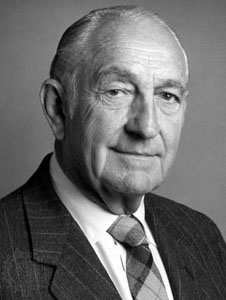History of Computers - David Packard
Introduction
David Packard (b. Sept. 7, 1912 d. Mar. 26, 1996) was an influential co-founder of Hewlett-Packard. Hewlett-Packard is the biggest PC producer in the world and produces many other high-end electronic devices, such as printers. Packard also served as the Deputy Secretary of Defense and as a government advisor.
Overview
David Packard was born in Pueblo, Colorado, and went to Stanford University in 1930, earning a bachelor of the arts degree in 1934 and a electrical engineering master's degree in 1939. He began work as an engineer for General Electric, but later that year, he partnered with William Hewlett, a former classmate at Stanford. With $538 dollars, they started their business by selling a sound oscillator to Disney. David Packard first sold scientific testing equipment until World War II, when his partner served in the army. [2]. While Hewlett was gone, Packard received a government contract for electronic measuring and safety equipment. In the 1960s, Hewlett and Packard invented the first electronic calculator as well as researching LED's. Because HP was behind in the computer industry, the two men decided to move on to printers and introduced the Laserjet and the Thinkjet, which were compatible to any computer at the time. While managing their company, David Packard and William Hewlett were known for giving their employees significant leeway and time for their own projects, a process known as the "HP Way."
Significance
In 1947, when HP became a legal company, Packard served as president until 1962, when he became CEO. After serving as Chairman of the Board for six years, President Nixon chose him as Deputy Secretary of Defense of the US from 1968 to 1971. As the second-highest ranking member of the Department of Defense, he brought a business mindset to the military, introducing the focus of resource management. He wrote the Packard Memo while in office, which stated that use of military forces in martial law was constitutional.
Philanthropy
After leaving office, he returned as chairman of the board for HP but devoted most of his time and money to philanthropic work. He also was the head of many engineering firms as well as an advisor for Boeing and Chevron. He died in 1996. [3]
Trivia
When David Packard and William Hewlett decided the name of their company, they flipped a coin to see which of their names would come first. Hewlett won, so instead of Packard-Hewlett, the company's name became Hewlett Packard. [4]
Hewlett and Packard turned down a young Steve Wozniak's Apple computer design, a mistake that almost set them behind in the PC world.
References
Links
http://www.hpalumni.org/hp_way.htm
Made by: Eric Gao
